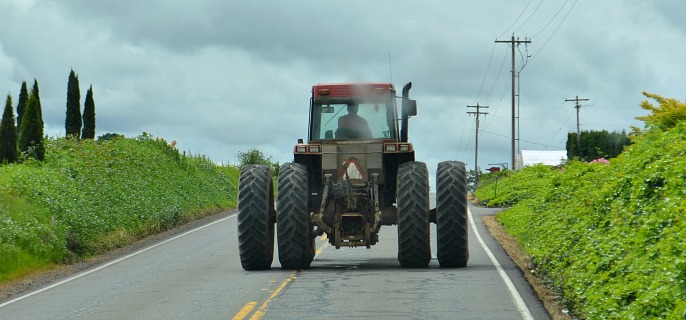
PHOTO COURTESY OF ODA
Motorists in Oregon this summer are likely to face heavier traffic due to vacation travel and road construction. Add in slow moving farm machinery during harvest and it’s a recipe that calls for ultra awareness and extra caution.
From the busy and crowded traffic lanes of the more congested Willamette Valley to the wide open spaces east of the Cascades, the general advice is the same – be on the alert, slow down, and have patience.
“There are more drivers on the road this time of year and there is more road construction,” says Katy Coba, director of the Oregon Department of Agriculture. “The constant message is slow down. That’s the exact same message we want to get across when it comes to the summer harvest season. If you see farm equipment on the road, please slow down.”
Farmers can legally drive trucks, tractors, combines, and other equipment on public roads. Sometimes this requires a tractor, combine, or farm truck to be out on the road, driving between 10 and 25 miles per hour to get from farm to field. This is perfectly lawful as long as the equipment has a clearly visible triangular, orange-and-red Slow Moving Vehicle (SMV) sign on its back end. That sign is a warning for drivers to slow down immediately.
Farmers normally try to avoid using high traffic roads as much as possible, but sometimes that just can’t happen. Urban development has moved closer to agricultural operations, which increases the risk of motor vehicle accidents involving farmers and non-farmers.
Amity farmer Bruce Ruddenklau was involved in an accident on Highway 99E just before the Fourth of July. His wife Helle says it was a miracle there were no injuries.
“Bruce was bringing the windrower home at 5:30 in the morning,” says Helle. “It was reasonably light out, all the road lights were on, including the flashing orange lights, and the SMV sign was clean and visible. [The driver of a car] approached from the back and ran straight into the left rear wheel of the windrower. The wheel snapped off, the windrower was pushed along at a higher speed than the 14 miles per hour it normally can go, and the car flipped over, grazed the side of the windrower and landed upside down on the roadway. Then in the evening [about a week later], while driving the combine home, somebody tried to pass Bruce on the left, just as he was about to turn left! Again, all the appropriate lights were on, and the turn signal was on. This happened only half a mile further up the road from where the windrower was hit. This time nothing happened, but it was still scary.”
Not all accidents involving farm machinery and motorists are so fortunate. Statistics provided by the Oregon Department of Transportation indicate 25 traffic accidents involving farm vehicles and equipment in 2015 and 40 in 2014, including three fatal crashes.
Education and awareness campaigns seem to be helping. In 2011, there were 235 motor vehicle accidents involving farm vehicles and equipment, resulting in eight fatalities.








